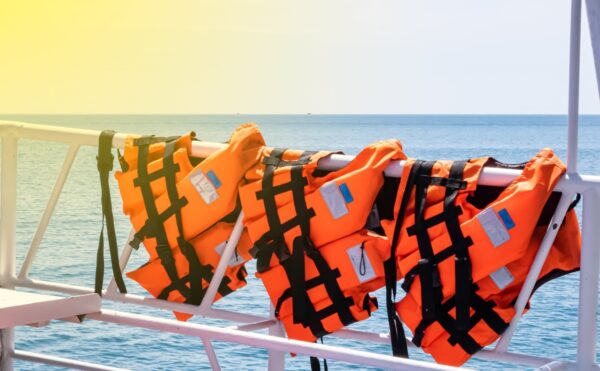On a quiet Monday night in Old Saybrook, Connecticut, tragedy struck when a 31-foot boat carrying nine people crashed into a jetty near the mouth of the Connecticut River. Investigative reporter Jeff Derderian explains that the crash left one man dead, two men missing, and six others injured, some critically. The boat was returning from Block Island when it collided with the jetty at around 9:15 p.m., and recovery efforts have been underway since.
The man who lost his life in the crash was 34-year-old Christopher Hallahan, a resident of Westbrook, Connecticut. Hallahan, a well-known contractor and active member of the community, was found dead on the boat. His wife was also on board at the time of the crash but survived. As of now, the search for the two missing men continues, while the boat operator remains in critical condition.
This devastating accident is a sobering reminder of the importance of boating safety, particularly during night-time travel when visibility and conditions can change rapidly. As the investigation unfolds, many in the community are left reflecting on what could have been done to prevent such a tragic event.
Boating Safety Tips: How to Stay Safe on the Water
Boating can be a wonderful way to enjoy the outdoors, but it comes with significant risks if safety precautions are not taken seriously. Whether you’re an experienced boater or new to the water, following key safety guidelines can help prevent accidents like the one in Old Saybrook. Here are some essential boating safety tips to keep in mind:
- Always Wear a Life Jacket
Wearing a life jacket is the simplest yet most effective way to prevent drowning in the event of an accident. Make sure there are enough life jackets on board for everyone, and that they are readily accessible. For children and non-swimmers, wearing a life jacket at all times is non-negotiable.
- Know the Waters
If you’re boating in unfamiliar waters, take time to study the area. Learn about any potential hazards such as jetties, rocks, or sandbars. In the case of the Old Saybrook crash, the boat hit a jetty at night, when visibility is naturally lower. Knowing the waterway and being aware of nearby structures can help prevent accidents, especially during night-time navigation.
- Check the Weather
Always check the weather forecast before setting out on the water. Sudden changes in weather can create dangerous conditions for boating. High winds, rough waters, and thunderstorms can all pose serious risks. If bad weather is expected, it’s best to postpone your trip.
- Never Drink and Drive
Operating a boat under the influence of alcohol or drugs is just as dangerous as driving a car under the same conditions. Alcohol impairs judgment, slows reaction times, and increases the likelihood of accidents. Many boating accidents, like car crashes, are related to alcohol consumption. To stay safe, designate a sober driver or avoid alcohol entirely while on the water.
- Follow Navigation Rules
Boating has its own set of rules and regulations, often referred to as “rules of the road.” These guidelines help prevent collisions and ensure that everyone on the water can navigate safely. Make sure you’re familiar with the local and federal boating regulations, especially in areas with heavy boat traffic.
- Maintain a Safe Speed
Excessive speed can lead to loss of control and increase the risk of accidents, especially in crowded or narrow waterways. Make sure to slow down when approaching docks, other boats, or areas with limited visibility. At night, always travel at a reduced speed to account for decreased visibility.
- Use Proper Lighting
Boating at night requires careful attention to lighting. Ensure that your boat’s navigation lights are functioning correctly and are turned on after sunset. These lights help other boaters see you and prevent collisions. Additionally, use a spotlight or flashlight to illuminate any obstacles that may be difficult to see in the dark.
- Take a Boating Safety Course
A boating safety course can provide invaluable knowledge on how to handle a boat safely, navigate different conditions, and respond to emergencies. Many states require boat operators to complete a safety course before heading out on the water. Even if it’s not mandatory in your state, taking a course is highly recommended.
- Have an Emergency Plan
In the event of an accident, knowing what to do can save lives. Make sure everyone on board is familiar with emergency procedures, including how to use a life jacket, how to call for help, and what to do if someone falls overboard. Keep a first-aid kit, fire extinguisher, and other emergency supplies on board and easily accessible.
- Stay Vigilant
Finally, always remain alert and focused while operating a boat. Distracted driving is a major cause of accidents, both on land and on the water. Pay attention to your surroundings, other boats, and changing water conditions. Being vigilant can help you anticipate and avoid potential hazards.
A Community in Mourning
As recovery efforts continue in Old Saybrook, the tragedy has left the local community in mourning. Christopher Hallahan’s passing has deeply affected those who knew him, and the search for the two missing men weighs heavily on everyone involved. Westbrook First Selectman John Hall expressed his condolences, calling Hallahan “a fine young man” who was deeply involved in the community. The Hallahan family, a well-established name in Westbrook, now grieves the loss of a beloved son, husband, and friend.
While this heartbreaking accident reminds us of the dangers of boating, it also serves as a call to action for all boaters to prioritize safety every time they head out on the water. By following boating safety guidelines and taking the necessary precautions, we can reduce the risk of accidents and ensure that every trip ends safely.
